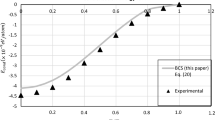Abstract
The spin-thermodynamics of a \(N\)-body spin-1 condensate containing only the spin-degrees of freedom is studied via a theory in which \(N\), the total spin \(S\) and its Z-component \(M\) are exactly conserved. The magnetic field \(B\) is considered as zero at first. Then the effect of a residual \(B\) is evaluated. A temperature \(T_3\) is defined as below that all the spatial degrees of freedom can be considered as being frozen and, accordingly, a pure spin-system will emerge. Effort is made to evaluate \(T_3\). When \(T\) goes up from zero, the internal energy \(U\) and the entropy \(S_E\) experience sharp changes in two narrow domains of \(T\) surrounding two turning temperatures \(T_1\) and \(T_2\), the latter is higher. When \(T<T_1\) or \(T>T_2\), \(U\) and \(S_E\) remain unchanged. Whereas when \(T_1<T<T_2\), \(U\propto T\) and \(S_E\propto \ln T\). It was found that \(T_1\) and \(T_2\) originate from the gap \(E_{\mathrm{gap},1}\) (the energy difference between the ground state (g.s.) and the first excited state) and the width (the energy difference between the g.s. and the highest state without spatial excitation) of the spectra, respectively. Thus their appearance is a common feature in spin-thermodynamics. In fact, \(T_1\) marks the lowest excitation of the spin-modes, while \(T_2\) marks the maximization of the entropy in the spin-space. In particular, the T-dependent population density is defined so that the theory can be checked by experimental data. Two kinds of condensates are notable: (i) the strongly trapped systems with a very small \(N\), they can work as pure spin-systems at relatively higher temperature; (ii) the systems with a high magnetization (say, \(N-|M|\le 4\)), the dimensions of their spin-spaces are very low. Furthermore, a larger \(\omega \) together with a large N (for Rb) or a large \(|M|\) (for Na) will lead to a sufficiently large \(E_{\mathrm{gap},1}\) so that a real g.s. can be experimentally created at a higher temperature. The spin-thermodynamics would remain valid whenever the spatial modes decouple from the spin-modes. This can occur at a higher temperature as demonstrated in Pechkis et al. (Phys Rev Lett 111:025301, 2013).






Similar content being viewed by others
References
J. Stenger et al., Nature 396, 345 (1998)
T.L. Ho, Phys. Rev. Lett. 81, 742 (1998)
T. Ohmi, K. Machida, J. Phys. Soc. Jpn. 67, 1822 (1998)
C.K. Law, H. Pu, N.P. Bigelow, Phys. Rev. Lett. 81, 5257 (1998)
H. Pu, C.K. Law, S. Raghavan, J.H. Eberly, N.P. Bigelow, Phys. Rev A 60, 1463 (1999)
J.M. Zhang, S. Cui, H. Jing, D.L. Zhou, W.M. Liu, Phys. Rev. A 80, 043623 (2009)
M.S. Chang, Q. Qin, W.X. Zhang, L. You, M.S. Chapman, Nat. Phys. 1, 111 (2005)
See the recent review, Y. Kawaguchi and M. Ueda. Phys. Rep. 520, 253 (2012). and references therein
B. Pasquiou, M. Marechal, L. Vernac, O. Gorceix, B. Laburthe-Tolra, Phys. Rev. Lett. 108, 045307 (2012)
H. Jing, D.S. Goldbaum, L. Buchmann, P. Meystre, Phys. Rev. Lett. 106, 223601 (2011)
B. Pasquiou, E. Marechal, G. Bismut, P. Pedri, L. Vernac, O. Gorceix, B. Laburthe-Tolra, Phys. Rev. Lett. 106, 255303 (2011)
A. de-Paz, A. Chotia, E. Marechal, P. Pedri, L. Vernac, O. Gorceix and B. Laburthe-Tolra, arXiv:1212.5469 (2012)
H.K. Pechkis, J.P. Wrubel, A. Schwettmann, P.F. Griffin, R. Barnett, E. Tiesinga, P.D. Lett, Phys. Rev. Lett. 111, 025301 (2013)
C.G. Bao, Z.B. Li, Phys. Rev. A 72, 043614 (2005)
F. Dalfovo, S. Giorgini, L.P. Pitaevskii, S. Stringari, Rev. Mod. Phys. 71, 463 (1999)
J. Mur-Petit, M. Guilleumas, A. Polls, A. Sanpera, M. Lewenstein, Phys. Rev. A 73, 013629 (2006)
W. Zhang, S. Yi, L. You, Phys. Rev. A 70, 043611 (2004)
H. Schmaljohann et al., Appl. Phys. B 79, 1001 (2004)
J. Katriel, Mol. Struct.:Theochem 547, 1 (2001)
C.G. Bao, Z.B. Li, Phys. Rev. A 70, 043620 (2004)
W. Pang, Z.B. Li, C.G. Bao, J. Phys. B: At.Mol. Opt. Phys. 40, 577 (2007)
C.G. Bao, J. Phys. A: Math. Theor. 45, 235002 (2012)
Acknowledgments
The project is supported by the National Basic Research Program of China (2008AA03A314, 2012CB821400), NSFC Projects (11274393, 11074310, 11275279), RFDPHE of China (20110171110026) and NCET-11-0547.
Author information
Authors and Affiliations
Corresponding author
Rights and permissions
About this article
Cite this article
Li, Z.B., Yao, D.X. & Bao, C.G. Spin-Thermodynamics of Ultra-Cold Spin-1 Atoms. J Low Temp Phys 180, 200–213 (2015). https://doi.org/10.1007/s10909-015-1305-y
Received:
Accepted:
Published:
Issue Date:
DOI: https://doi.org/10.1007/s10909-015-1305-y




